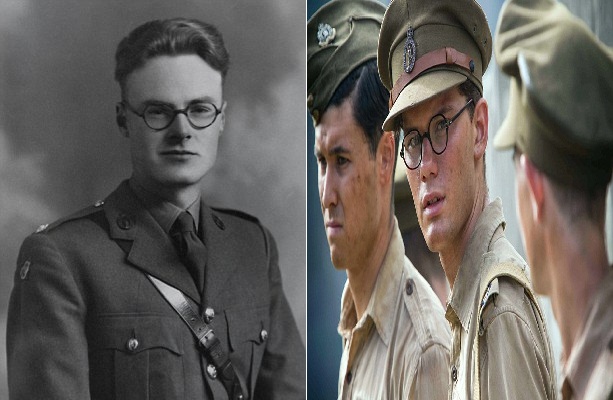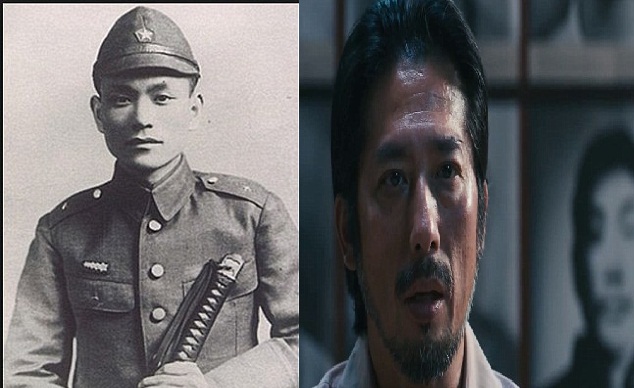
WWII movie “The Railway Man” is a moving account of a prisoner of war’s experience in war, in love, hating, forgiving and moving on. Meet the people behind the the characters portrayed by Colin Firth and Nicole Kidman in the movie.
The Beginning
Patti’s first meeting with Eric Lomax was an unforgettable affair. She was on her way to Glasgow to see a friend. The train she was in stopped at Crewe and her eyes landed on a somewhat ruffled man standing on the platform.
“I just knew, in that instant, that he was going to mean something to me. And it was no surprise when, a couple of minutes later, he came on board and asked if he could take the seat opposite,” she recounted.
She learned of his name soon after and though he was not good-looking in a conventional way, she was drawn by the beautiful blue-grey eyes behind that thick-rimmed glasses of his and wanted to “drown herself into them”.
He commented on the book resting on her lap and that started their 3-hour nonstop conversation. When the train pulled off Glasgow Central, Patti agreed to have lunch with him the next day.
That “love at first sight” moment in Patti’s life some 30 years ago is the opening scene of “The Railway Man”, a film based on Eric’s life, his harrowing experience as a PoW at work in the Burma Railway during WWII and how he was able to completely forgive his greatest tormentor during those dark years. More than a historic account, Eric Lomax’s story is one of love, hatred, forgiveness and of moving on.
The Railway Man

“The Railway Man” narrates the unspeakable horrors British prisoners of war, most specifically Eric Lomax, endured in the hands of their Japanese captors after the fall of Singapore and the building of the ill-famed Burma Railway dubbed as the “death railway”.
But beyond the tell-all account of this dark part in history, love plays a central theme throughout the movie – love between the troubled central character and his lady love whose patience and sensitivity played a vital part in allowing him to let go of his tortured past and learn to forgive.
Colin Firth, who played the older Eric Lomax in the movie, even commented how Patti is “the miracle in Eric’s life”, the praise making the latter blush furiously but tinge her heart with sadness, too.
“The Railway Man” rend those who have watched its advanced screening to tears as well as have earned acclaim with the screenings ending to enthusiastic applause from the audience.
However, Eric Lomax did not get to see the whole of the cinematic adaptation of his life; he passed away last October 12, 2013 at the ripe age of 93, it was shortly after the shooting for the movie wrapped up but before he could see its full edit.
“Watching Colin as Eric is hard. He’s marvelous and there are moments on screen when I catch an expression on his face and he almost could be Eric,” Patti admitted after watching the movie.
The actor, who have received a number of Oscars for his craft, had been a frequent visitor to the Lomax’s home in Berwick-upon-Tweed as the film was being filmed; Patti had even placed a framed photo of him and Eric in conversation in her sitting room.
“They became very close and I admire Colin for that, because my husband was never an easy man to get to know,” she said about her husband and the actor’r unlikely friendship.
Their Thrilling Love Affair
Neatly trimmed hair in place, reasonable shoes and gentle manner…it would never occur to anyone that this woman had been involved in a provocative love affair.
She even had a longstanding joke about herself and how her mother had always warned her about talking to “strange men in trains”. Nevertheless, she was already 43 years old when that fated meeting with Eric on the train happened, more than a time act upon solely on her decision.
Patti was a former nurse who migrated in Canada at the age of 22 after getting married to a Canadian Air Force member. Her first marriage blessed her with three sons and a daughter but it, she said, a connection devoid of the spark that could have seen it through until “til death do us part”.
“In those days, if you wanted to make love, you had to get married, so we did. And we had a lot in common while the children were small, but once they had grown up, we had nothing to talk about,” she said.
She was in Britain in a solo trip to see her mother, sisters and a number of old friends when she crossed paths with Eric. A man who was “shy, but with a light sense of humor” was her first impression of him. He entertained her with his sketches about trains and she found out in the long run that he was an avid railway aficionado.
“[and] he was just so knowledgeable and interesting and he talked in such a magical way that I was totally seduced,” Patti added.
When she returned to Canada, their meetings turned to a letter correspondence and phone calls in which Eric gave an edited version of his life’s story.
He was 17 years her senior at 60 – though Patti commented that it was hard to notice that given his boundless energy – was working at Strathclyde University as a business management lecturer and like her, was stranded in a lifeless marriage. He also told her a little about his experience in war, how he was a Royal Signals officer during WWII and became a PoW after the fall of Singapore in 1942.
“And that was where his telling of his wartime experiences stopped,’ says Patti. ‘He would never tell me more than that,” Patti spoke out.
Two years after their first meeting, Patti left Canada to be with Eric; in 1983 they got married. At this time, Patti’s children in her first marriage were all grown up – in their teens and late 20s – while Eric’s daughters in his first marriage were also grown up.
“It was very traumatic and I caused an upheaval which I felt terrible about,” she said about the breaking up of their families just so they could be together.
But while Patti remained to be fond of her ex-husband, who, she said, is faring better with his new partner than when he was with her; she had this compelling love for Eric.
“There was just something which made me feel that he needed me,” she said.
Eric’s Hell

In the long run in their relationship, Patti realized that Eric was projecting two personalities – there was the Eric who put up a brave front for the world to see and the vulnerable Eric who would be withdrawn for days.
It was when she lived in the same roof with him that she witnessed the violent nightmares that plagued him. She would wake up to his fits of raging screams and would find him on the floor, writhing and in cold sweat.
“The following morning he would be exhausted and would apologize for disturbing me, but he couldn’t talk about what was troubling him,” she recounted.
Then there were the surprising icy rages that often were his nightmares’ aftermath. Eric would suddenly get angry at the most unlikely causes like questioning in the bank. She also witnessed how he would leave upon seeing Japanese tourists in a restaurant they planned on eating in.
She even remembered one incident where she playfully threw at him a wet dishcloth only to be met with rage and withdrawal that lasted for days. It turned out, her gesture which was meant as a joke had reminded Eric of the waterboard torture he was subjected to during his years as a PoW in Burma that almost got him drowned.
After five years of walking in eggshells around him, Patti voiced out her final proposal to Eric:
“I told him that although I loved him I couldn’t live with him as he was, and that unless he sought help I would leave him.”
They went to a psychiatrist after that and, through the Medical Foundation for the Care of Victims of Torture, was able to get the help Eric needed for his post-traumatic stress.
Patti was in Eric’s every counselling session – every one of them an eye-opener for her.
She learned that while working side by side with over 60,000 other Allied PoWs in the Burma-Siam Railway, Eric built and kept a secret radio that allowed him to keep in touch with the war events outside of the camp but this was discovered in August 1943.
Because of the radio’s discovery, Eric, along with six other PoWs, were made to stand under the searing heat of the sun for hours without any food and drink after which they were systematically beaten with pickaxe handles until they succumbed to unconsciousness. Two of the PoWs who were with him died due to the attacks while Eric was left lying with cracked ribs as well as broken arms and hips on the ground for two days.
But his hell did not end there. He was subjected to endless interrogation and more torture like being kept in a cage the size of a coffin for hours’ time. He was then found guilty “of anti-Japanese activities”, sentenced to five years of hard labor after which he was sent to a disease-ridden jail until his liberation.
When freedom came after VJ Day in August 1945, the weakened and pale Eric was sent home to Southampton but nobody came to meet him. He found out his mother had died three-and-a-half years earlier after believing that he was dead in action and his father had remarried an old family friend whom he never really liked. So instead of going home, he sought his fiancée before the war and married her.
But then, wrapped up in his own demons and the inability to talk about any of his war experience to his new bride meant their marriage had died right before it could even blossom. Their marriage difficulties even increased when they lost their son right after birth and their older daughter came down with brain hemorrhage making her suffer ill health right after.
A mixture of overwhelming emotions assaulted Patti as Eric’s story unraveled for her inside the counselling room.
“I felt this immense outpouring of love and relief that at last I could understand what he’d been through. But I also felt hatred for the inhumane perpetrators who had done this to him,” she said.

Eric had singled out one Japanese tormentor to become the symbol of the evil he endured throughout those dark years in his life – that was Takashi Nagase, the Japanese interpreter who dauntlessly accused him of being a spy as other Japanese soldiers inflicted upon him their cruel acts.
In time, a fellow PoW in Burma passed on to him a clipping of the then 71-year-old frail Japanese man who, at that time, was seeking forgiveness for his role during the war by putting up a charitable foundation and building a Buddhist shrine right next to the “death railway”. But Eric had not found in his heart the forgiveness the man asked and had even fantasized about extracting his revenge.
It was Patti who first contacted the Japanese man by writing to him:
“How can you feel “forgiven”, Mr Nagase, if this particular former Far Eastern prisoner of war has not yet forgiven you?”
Nagase’s humility-filled reply to her letter was this:
“The dagger of your letter thrust me into my heart to the bottom.”
She was with Eric when he flew to Thailand to meet Nagase, his old tormentor, right on the Kwai Bridge which was part of the Burma-Siam Railway. She was very nervous at that time because right to the last minute, Eric had threatened revenge and was planning to do the Japanese man harm. However, at their meeting, Eric turned forgiving and it was Patti who found it hard to find forgiveness for the Asian man in front of her.
“I was living with the consequences of what happened to Eric. But he was the one who said, “Sometime the hating has to stop.” So I gave myself a good talking to and said if it was all right with Eric, then who was I to remain angry?” she said.
After the initial meeting, the Lomaxes remained in connection with the Nagases and a friendship developed between the two couples until the deaths of the latter. It turned out, Nagase and Eric had many things in common – they both loved history and shared a passion for books.
After the war, Eric had written a 40,000-word account about his war experience. he quickly revisited this after his meeting with Nagase transforming it into a moving autobiography published in 1995 which in turn led to what is now the movie, “The Railway Man”.
Patti on the Movie
Patti was full of admiration for Jeremy Ervine, who played the young Eric Lomax in the movie. The actor had insisted on doing the waterboarding torture scenes for real.
“We should watch him – he is going to be a great actor,” she said.
As for Nicole Kidman who portrayed her in the film, she found her acting very satisfying.
Nicole had spoken highly about Patti after spending tea one afternoon with the couple. According to her, as someone who stood by her partner through hard times, she feels strongly for Patti. She had made her believe strongly in how love could heal by gentle encouragement and persistence.
As for Patti, she spoke well about the actress.
“I knew she had been married to Tom Cruise and that they had been in the papers a lot over their marriage, and I did think, ‘Here is somebody who has had to protect her husband – in her case from the public and the media’,” she said.
“We got on very well. She is a deep person. And she has done a good job in capturing me.”
Patti felt sorry that Eric did not get to see the final cut of “The Railway Man” but at the same time relieved since for her, it would have just resurrected distressing memories that Eric had tried hard to forget.
Though the WWII vet mellowed after his therapy, it never completely rid him of his personal demons.
“I think we became one. We were so close that we used to finish each other’s sentences.”
“In all our 32 years together, he never once told me he loved me. And then the day he died, I heard a voice from his bed saying: “Patti, is that you?” And when I went to him, he said: “Patti, I do love you”. So in the end I did know,” she fondly recalled.
In his grave she had his own words inscribed: Sometime the hating has to stop.
The Railway Man will be shown in cinemas starting January 10.